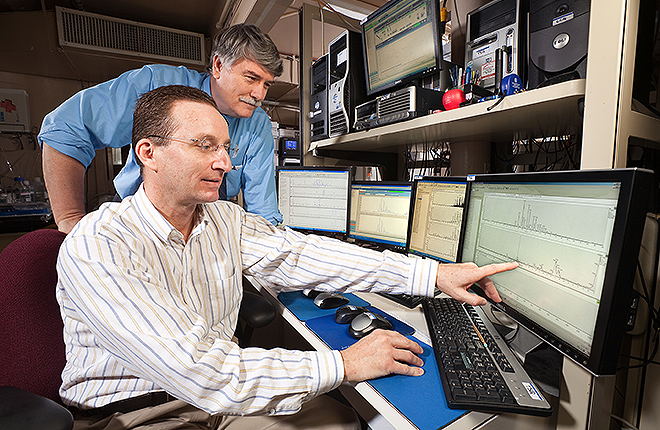A Definitive Way To Profile Our Nutrients
If you want to know the nutrient content of a specific food or beverage – how much vitamin D there is in a glass of milk, for instance – you would do well to consult W. Craig Byrdwell.
Byrdwell, an analytical chemist in the Agricultural Research Service (ARS) Food Composition and Methods Development Laboratory (FCMDL) in Beltsville, Maryland, is at the forefront of developing methods to determine exactly which nutrients are in the foods we eat and at what levels.
“He is using technologies in unique ways and getting down to an unparalleled level of detail in his analysis. It is groundbreaking work,” says Giorgia Purcaro, a chemistry professor at Dartmouth College who is an expert on emerging techniques for detecting chemical signatures in foods and the environment.
Byrdwell has found a way to use seven different pieces of laboratory equipment – four mass spectrometers, two liquid chromatographs, and a gas chromatograph – in complementary ways to capture definitive nutrient profiles of our foods.
|
|
Knowing the nutrient levels in our foods is critical to coming up with dietary recommendations regarding those nutrients as well as ensuring that we get enough of them. Vitamin D, for instance, is often added to milk, breakfast cereals, orange juice, and other products because it is important for healthy bones and teeth.
A decade ago, the National Academy of Sciences (NAS) became concerned about conflicting information regarding vitamin D levels needed for a healthy diet. NAS decided to update the nutritional reference values, known as the Dietary Reference Intakes (DRIs) for vitamin D. Researchers soon discovered, however, that different studies were coming up with different vitamin D levels in the same foods.
Byrdwell’s comprehensive approach was a key to resolving those discrepancies by providing a definitive way to evaluate a food sample. The NAS updated the DRIs for vitamin D in 2010. To this day, Byrdwell’s methods are the reason why scientists can say with certainty that the amount of vitamin D in a fortified serving of milk, cheese, or other food product is at a level where it should be.
“There was uncertainty about the accuracy of the analyses of vitamin D and other fat-soluble compounds done on foods years ago, but Craig has eliminated that uncertainty,” says James Harnly, research leader of the FCMDL, which is part of the ARS Beltsville Human Nutrition Research Center. “I would say Craig is the world’s leading expert on the analysis of vitamin D, and that is not a trivial analytical problem.”
Over the years, Byrdwell has also identified vitamin D levels in fish oils, corrected misconceptions about vitamin D levels in oysters (the levels aren’t as high as preliminary studies indicated), and developed nutrient profiles of nutritional supplements, soybean oil, and various fruit drinks. He is now applying his methods to kale and vegetable juices. Researchers have used his approach to determine levels of other essential fat-soluble vitamins, such as vitamins A, E, and K.
Standard methods for determining a nutrient profile usually use liquid chromatography with detection by ultraviolet (UV) light absorption. Ultraviolet light will reveal the presence of vitamins, minerals, and fatty acids essential for human health. But Byrdwell says that UV readings don’t always give an accurate picture of the level of a specific compound. He says his approach, using an array of mass spectrometers, is more definitive because among other things, it reveals the molecular structure of nutrients, which determines the nutrient’s “bioavailability,” or how well it is likely to be absorbed by the human body.
In a recent report on his methods, Byrdwell not only determined for the first time how much vitamin E (tocopherols) was in a type of African plum (Parinari curatellifolia), but he also found class of fats (oxo-triacylglycerols) not previously known to be in the plum. The plum itself is not likely to be appearing in supermarket produce sections any time soon, but the results show how Byrdwell has improved on his approach in recent years and the value of using it.
“If it works on this plum or the cherry pit seed oil we studied, it would work on other foods as well,” Byrdwell says.—By Dennis O’Brien, ARS Office of Communications.
Key Facts
- ARS develops methods to determine the nutrient content of foods.
- One technique uses seven detectors to capture definitive nutrient profiles.
- The data is used to make dietary recommendations to ensure we get enough nutrients.
Full Story








